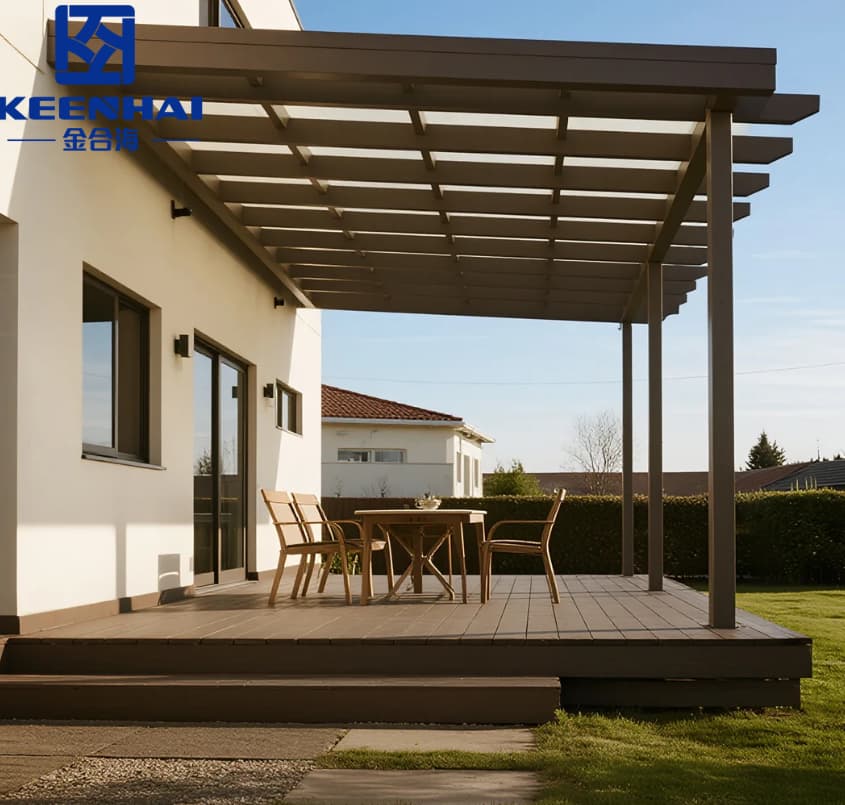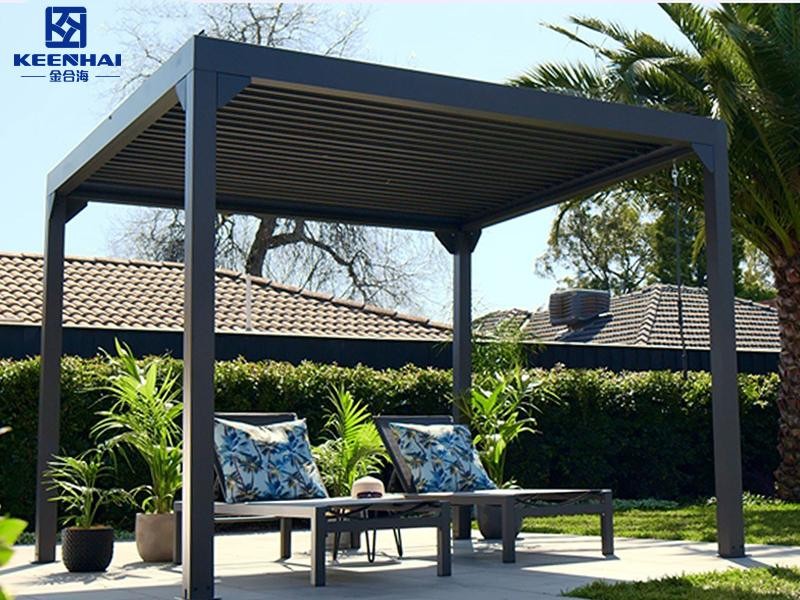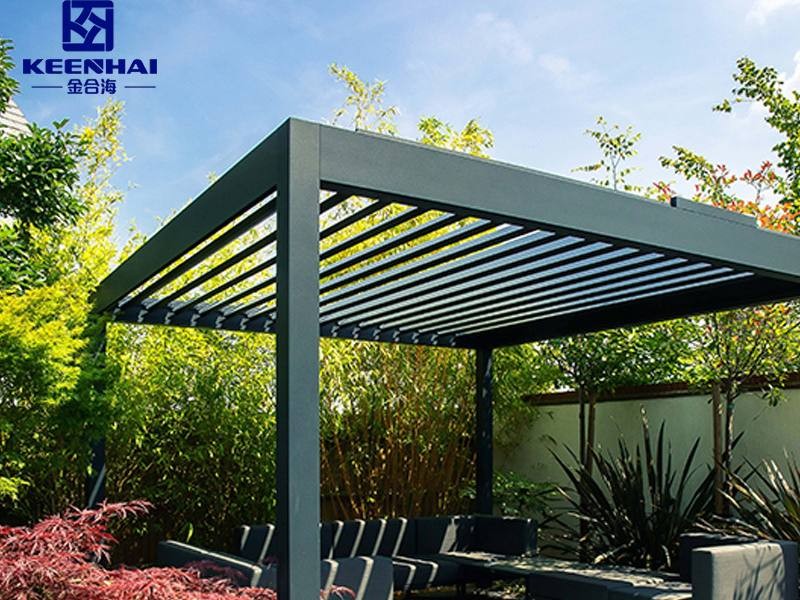
1.Aluminum Pergola Benefits
1.1Lightweight and Easy to Install
Aluminum pergolas weigh between 15-25 kg per square meter, which is roughly 50-70% lighter than traditional wood. This makes them much easier to handle during installation. For example, a backyard aluminum pergola measuring 3m x 4m can be installed by a team of 2-3 people in just 6-8 hours, compared to a similar wooden pergola that often requires 8-12 hours and 4-5 people. Many homeowners choose Aluminum Pergola for DIY projects because the lightweight frame reduces physical strain and allows for modular assembly.
Low Maintenance and Rust Resistant
Aluminum frames resist rust, corrosion, and insect damage, which makes them ideal for coastal areas or regions with high humidity. Unlike wood, which requires annual staining or sealing, aluminum pergolas need only occasional cleaning with soap and water. Studies show that over a 10-year period, aluminum pergolas save homeowners $500-$1,200 in maintenance costs compared to wood, depending on size and local labor rates. The powder-coated finishes on modern aluminum structures can last up to 15 years without fading, keeping the pergola looking fresh and new.
Modern Look and Customizable Finishes
Aluminum pergolas offer a contemporary aesthetic that fits minimalist and modern landscapes. Homeowners can choose from over 12 powder-coated colors and textures, including metallic and matte finishes. Many choose the Aluminum modern pergola style for rooftop terraces or patio extensions because it can be combined with glass panels, retractable roofs, or LED integrated lighting. For instance, a residential rooftop installation in California used custom 4x5m aluminum pergolas with glass louvered roofs, providing a sleek modern vibe while remaining lightweight and durable.
1.2Wood Pergola Benefits
Natural and Classic Appearance
Wood pergolas bring warmth and a natural touch to gardens and patios. Cedar and redwood are popular choices because of their rich color, tight grain, and natural oils, which help resist decay. A typical 3m x 4m cedar pergola weighs about 50-60 kg per square meter, giving a robust feel underfoot. Homeowners often appreciate the aesthetic versatility: it can be painted, stained, or left to naturally weather into a silvery-gray patina over 5-10 years, creating a timeless, classic look.
Strong Structural Integrity
Wood has a high modulus of rupture (MOR) of 70-90 MPa for cedar, which allows it to support heavier roof elements like climbing plants, fabric canopies, or solar panels. In a case study, a suburban backyard in Texas installed a 6x5m redwood pergola, which safely held over 150 kg of hanging planters and lighting fixtures without noticeable sagging over 8 years. The robust frame ensures stability even in high winds up to 120 km/h, making wood a dependable material for large outdoor structures.
Flexible Design Options
Wood is highly customizable. Carpenters can craft curves, arches, and intricate lattice designs, which are difficult or costly to replicate with aluminum. Dimensions can vary from 2x2m small patio covers to 6x6m outdoor dining pergolas, and wood can be easily adapted to uneven terrain with adjustable footings. A lakefront property in Oregon utilized custom redwood beams for a multi-tiered pergola system, providing shaded seating zones and climbing plant support, showcasing how wood adapts to complex garden layouts.
Aluminum vs Wood Parameter Comparison
| Feature | Aluminum Pergola | Wood Pergola |
|---|---|---|
| Weight per m² | 15-25 kg | 50-60 kg |
| Installation Time | 6-8 hours | 8-12 hours |
| Maintenance Cost (10 years) | $0-$200 cleaning only | $500-$1,200 (staining/sealing) |
| Lifespan with Proper Care | 15-20 years | 15-25 years |
| Weather Resistance | High, rust and corrosion-proof | Moderate, needs protection from rot |
| Customization Options | 12+ colors, glass panels, LED lighting | Paint, stain, carve, lattice, arched designs |

2. Material Drawbacks
2.1 Aluminum Pergola Cons
Can Feel Less “Natural”
Aluminum pergolas, while sleek and modern, often lack the warmth and organic feel of wood. Homeowners who prioritize a garden that blends seamlessly with greenery may notice that aluminum frames feel more industrial. Even with textured powder-coated finishes, aluminum rarely matches the rich grain patterns or natural color variation of cedar or redwood. A rooftop patio in Florida installed a 4x4m aluminum pergola for shade, but the homeowner added climbing vines and bamboo panels to soften the modern metallic appearance and create a cozier atmosphere.
Limited Color Options without Coating
Standard aluminum typically comes in basic silver, white, or gray tones. To achieve bold colors like matte black, bronze, or custom metallics, powder coating is required, which can add $150-$400 to the total installation cost depending on pergola size and finish quality. Powder coating extends the life of the pergola by preventing minor scratches and oxidation, but homeowners who want frequent color updates will face additional cost and labor.
Higher Initial Cost in Some Cases
Although aluminum reduces long-term maintenance costs, the initial price per square meter ranges from $250-$400, compared to basic cedar wood pergolas at $180-$300/m². In one suburban project, a 3x5m aluminum pergola cost around $3,750 for materials and installation, while a similar cedar pergola cost $2,700, highlighting that aluminum requires higher upfront investment despite being lighter and lower maintenance.
2.2 Wood Pergola Cons
Requires Regular Maintenance
Wood pergolas demand ongoing attention. Cedar or redwood must be stained or sealed every 1-2 years to preserve appearance and prevent moisture damage. Failing to maintain the wood can reduce its lifespan by 30-50%. A homeowner in Oregon reported that skipping annual maintenance led to noticeable cracking and discoloration in just 4 years, which required sanding and resealing at a cost of $250-$350.
Susceptible to Rot and Termites
Even naturally resistant wood types like cedar and redwood are vulnerable in humid climates or areas with high termite activity. In the southeastern United States, over 15% of outdoor wooden structures experience some termite damage within the first decade. Preventive measures like borate treatment or regular inspections are essential and can add $100-$200 annually for a standard 3x4m pergola.
Can Warp or Crack Over Time
Wood expands and contracts with temperature and moisture changes. A backyard pergola in Texas made of untreated cedar developed 2-5 cm of bowing along horizontal beams over 8 years, affecting alignment of attached fabric canopies. Homeowners need to allow slight gaps for expansion and monitor for early signs of warping. Choosing premium kiln-dried wood reduces, but does not eliminate, these effects.
2.3 Aluminum vs Wood Parameter Comparison
| Drawback | Aluminum Pergola | Wood Pergola |
|---|---|---|
| Natural Feel | Low, industrial look | High, warm and organic |
| Color Flexibility | Limited without powder coating | Can paint/stain any color |
| Initial Cost per m² | $250-$400 | $180-$300 |
| Maintenance | Low, occasional cleaning | High, staining/sealing every 1-2 years |
| Vulnerability | Rare, mostly scratches | Rot, termites, warping |
| Lifespan Risks | Low | Moderate if poorly maintained |

3. Cost Comparison
3.1 Installation Costs
Aluminum Pergola Installation
Installing an aluminum pergola is generally straightforward because of the lightweight frame. For a standard 3x4m pergola, materials cost ranges from $1,000 to $1,500, depending on powder coating and finish. Professional installation adds another $500-$900, bringing the total to $1,500-$2,400. Homeowners often complete DIY setups in 6-8 hours, but professional installation ensures perfect alignment, proper anchoring, and warranty coverage. For instance, a rooftop terrace in California used a 4x5m aluminum pergola with powder-coated panels, installed by two technicians in a single day, which minimized disruption and prevented damage to the roof surface. You can check a practical option here: Aluminum Pergola.
Wood Pergola Installation
Wood pergolas typically require heavier lifting and more labor. A cedar pergola of similar size costs $800-$1,200 for materials, with installation adding $700-$1,000, totaling $1,500-$2,200. Installation often takes 8-12 hours and may require 3-4 workers. In one suburban backyard project in Texas, a 3x5m cedar pergola needed additional leveling and post bracing due to uneven terrain, extending labor time but providing a sturdy, classic frame. Wood installation offers more flexibility for custom arches, lattice, or multi-tier designs but requires more effort and precision.
3.2 Long-Term Maintenance Expenses
Aluminum Pergola Maintenance
Aluminum pergolas demand minimal upkeep. Occasional cleaning with soap and water costs $0-$50 per year. Powder-coated finishes may require touch-ups every 10-15 years, which is rare in most residential applications. Aluminum does not warp, crack, or attract termites, so the total maintenance expense over 10 years rarely exceeds $200. This makes it ideal for homeowners who prioritize low-effort outdoor structures.
Wood Pergola Maintenance
Wood requires annual or biannual sealing and staining, costing $150-$350 per treatment depending on pergola size and labor. In humid or termite-prone areas, inspections and preventive treatments add $100-$200 per year. Over 10 years, maintenance costs can reach $1,500-$2,500, which may exceed the initial installation cost of some wood pergolas. For example, a cedar backyard pergola in Oregon needed resealing, minor post replacement, and termite preventive treatment every year to maintain structural integrity and aesthetic appeal.
3.3 Aluminum vs Wood Cost Comparison
| Cost Factor | Aluminum Pergola | Wood Pergola |
|---|---|---|
| Material Cost (3x4m) | $1,000-$1,500 | $800-$1,200 |
| Installation Cost | $500-$900 | $700-$1,000 |
| Total Installation Cost | $1,500-$2,400 | $1,500-$2,200 |
| Maintenance (10 years) | $0-$200 | $1,500-$2,500 |
| DIY Installation Time | 6-8 hours | 8-12 hours |
| Professional Installation Time | 1 day | 1-2 days |

4. Longevity and Durability
4.1 Aluminum Lifespan and Weather Resistance
Extended Lifespan
Aluminum pergolas are highly durable, with a typical lifespan of 15-20 years, depending on environmental conditions and finish quality. Powder-coated aluminum resists fading, scratches, and minor dents, keeping structures visually appealing for years. Coastal homes with high humidity or salt exposure often choose aluminum because it resists corrosion better than wood, maintaining structural integrity even after prolonged exposure to sun, rain, or wind.
Weather Resistance in Practice
Aluminum frames withstand temperature swings from -20°C to 50°C without warping or cracking. In a case study from Florida, a 4x5m aluminum pergola installed on a rooftop terrace endured hurricanes with wind speeds exceeding 130 km/h without any deformation. Snow load is also less of a concern; a standard aluminum pergola with louvered panels can support up to 50 kg/m² of snow, making it a practical choice for regions with occasional snowfall.
Custom Finishes Enhance Durability
Using high-quality powder coating or anodizing can extend lifespan by 5-10 years while preventing minor oxidation. Homeowners can select finishes that repel dirt and reduce water spotting, further lowering maintenance time. For modern outdoor spaces, the Aluminum Pergola remains an attractive option for long-term reliability and low upkeep.
4.2 Wood Lifespan and Environmental Sensitivity
Lifespan Variability
Wood pergolas have a broad lifespan range, typically 15-25 years, heavily influenced by material type, treatment, and maintenance. Cedar and redwood are naturally resistant to decay, but untreated or poorly maintained wood can lose 30-50% of expected lifespan within 5-10 years, especially in humid or termite-prone areas.
Environmental Sensitivity
Wood reacts to moisture and temperature changes, causing expansion, contraction, cracking, or warping. For example, a cedar pergola in Oregon required adjustments to horizontal beams every 2-3 years due to natural bowing. Termites and fungal attacks remain a concern in many regions, necessitating annual inspections and preventive treatments costing $100-$200 per year for a standard 3x4m pergola.
Case Study: Wood Pergola in Action
A 5x6m redwood pergola in Texas successfully supported climbing plants, LED lights, and a retractable canopy for over 10 years. Regular sealing and minor beam replacements were needed, but the structure remained strong and visually appealing. Wood allows homeowners to customize shapes and textures in ways aluminum cannot, but this flexibility comes with a higher ongoing maintenance demand.
4.3 Aluminum vs Wood Durability Comparison
| Feature | Aluminum Pergola | Wood Pergola |
|---|---|---|
| Lifespan | 15-20 years | 15-25 years (with maintenance) |
| Weather Resistance | High, resists rust, wind, snow, UV | Moderate, affected by moisture & UV |
| Temperature Tolerance | -20°C to 50°C | Varies, may warp or crack |
| Snow Load Support | Up to 50 kg/m² | Dependent on wood type, may sag |
| Maintenance Requirement | Low | High, annual sealing & inspections |
| Environmental Sensitivity | Minimal | High, moisture & pests impact |
